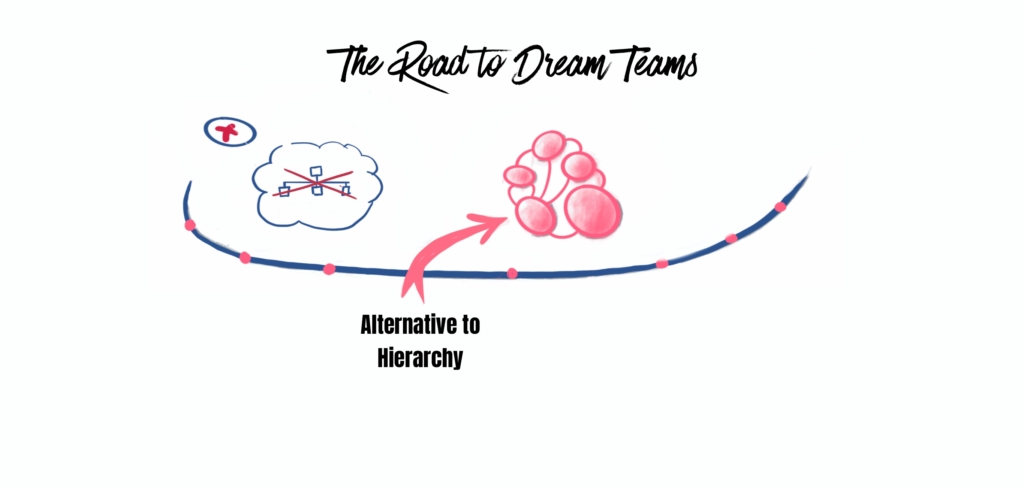2 (3)
THE LEADERSHIP GROUP HAD FIRED THEMSELVES – now the time had come for the employees
The leadership team had been tasked by the CEO to help introduce SELF-MANAGING TEAMS.
And no – no employees were to be layed off. But how were they all going to manage this change?
By Leise Passer Jensen 18. November 2023
The CEO would still be CEO after the changes. He had said to the middle managers:
“The hierarchy and middle management layers are gone now.
The new organisational form must be self-managing teams in a network organisation.”
They had discussed this in the team, and had agreed to voluntarily support the CEO’s proposal.
They just didn’t realise what to do from here.
Not everyone was enthusiastic about the new approach.
But this was an experiment. If less than 80% of the employees agreed to the idea, they would go back to the old traditional hierarchy. The CEO had promised that.
He had already mentioned 5 preconditions:
- Volunteerism
- Trust and confidence
- Transparency
- Commitment
- We know our Purpose
You can read about what had happened prior to this here.
This was now his biggest concern:
Would they fall back into the well known traditional hierarchy when they got into trouble?
.
THIS IS A TRUE STORY
.
It’s the story of The Morning Star Company’s transformation to self-management 30 years ago. The CEO is Chris Rufert.
Read on to find out how Chris Rufert made the transformation.
He did it TOGETHER with his colleagues.
.
The Morning Star Company is one of the world’s most successful tomato processing companies. They have R&D, logistics, production, etc. – a fairly complex set-up with over 4000 employees. For 30 years, they’ve maintained self-managing teams and still use the same principles.
Here are their 2 invariable UNIVERSAL PRINCIPLES:
- Everyone does what is agreed upon.
- No one can force another person to do anything against their will.

THE FIRST BOUNDARIES ARE INTRODUCED
Chris Rufert had formulated the first version of the new boundaries.
He knew that when something as essential as the chain of command via middle management was removed, there was a great need for new principles and guidelines to be communicated immediately.
Chris had heard of a few companies that had simply set employees free and left them to figure out the rest themselves. That had gone totally wrong. People got sick, stressed, started bullying and worse.
So, Chris communicated the following seven guidelines:
- A coaching and mentoring model replaces the right of managers to decide
- No one has titles – but everyone has one or more well-defined roles
- Everyone calls each other ‘colleagues’ (no one is an ’employee’)
- Feedback is a way to grow and learn from mistakes
- Accountability process supports the company’s mission
- No one can control others against their will
- No one can fire others on their own
ACCOUNTABILITY AND FREEDOM
Chris Rufert had decided that his company would be founded on FREEDOM. Freedom to act responsibly in pursuit of the company’s mission.
He believed that since adults are able to exercise self-leadership in their personal lives (e.g. finding their own life partner, getting married, having children, getting into debt, working in volunteer organisations and generally managing life’s challenges and ups and downs on their own without e.g. ‘family managers’), they would also be perfectly capable of working in and with self-managing teams at The Morning Star Company.
Therefore, he added the 8th point to the preliminary framework:
8. Freedom
Freedom would mean that all use of force was banned from now on.
This included the power to determine other people’s career paths, salary compensation and everything that had previously been the right and duty of formal middle managers to decide over ‘their subordinates’.
Concern rose again among the members of the former leadership team.
“How are we ever going to get anything done when all results have to be achieved by influencing and persuading colleagues?“
Chris Rupert was prepared for this question.
The answer was to be found, among other things, in the future way of decision-making in the company, and he had an answer for that. As well as a number of other essential descriptions of how colleagues work together.
You can read more about this and much more in the next newsletter.
Thank you for reading.
– Leise Passer Jensen
Sign me up to more newsletters from Leise
If you liked what you read, and you are not already signed up for those newsletters, sign up here.
Sources and where to read more
Sources: The No Limit Enterprise by Doug Kirkpatrick
Read all newsletters here.

Article: Stop imposing
.
Read it here.


